

05/2005
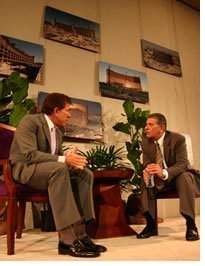 At the conclusion of
the first full day of the 2005 AIA National Convention, approximately
1,000 architects gathered at Las Vegas’s newest luxury hotel, the
Wynn Las Vegas, to participate in a discussion between megadeveloper
Steve Wynn and his architect, Tony Marnell, AIA, CEO of Marnell Corrao
Associates. Christened April 28, the 50-story, $2.7 billion Wynn Las
Vegas offers guests 2,716 rooms, 19 restaurants, a 2,087-seat showroom,
74,700 square feet of retail space, a 111,000-square-foot casino, and
an exclusive 18-hole golf course. In addition, the hotel contains a full-service
Ferrari and Maserati dealership and an art gallery displaying works of
the Impressionist masters from Wynn’s collection.
At the conclusion of
the first full day of the 2005 AIA National Convention, approximately
1,000 architects gathered at Las Vegas’s newest luxury hotel, the
Wynn Las Vegas, to participate in a discussion between megadeveloper
Steve Wynn and his architect, Tony Marnell, AIA, CEO of Marnell Corrao
Associates. Christened April 28, the 50-story, $2.7 billion Wynn Las
Vegas offers guests 2,716 rooms, 19 restaurants, a 2,087-seat showroom,
74,700 square feet of retail space, a 111,000-square-foot casino, and
an exclusive 18-hole golf course. In addition, the hotel contains a full-service
Ferrari and Maserati dealership and an art gallery displaying works of
the Impressionist masters from Wynn’s collection.
2005 AIA President Douglas L Steidl, FAIA opened the event with words of welcome to the guests of honor and audience. “In her book, The Economy of Cities, Jane Jacobs challenges conventional assumptions about wealth and innovation, conventions that would attribute the rise of cities to advances in rural economies. Jacobs says we have it backwards: it’s cities that drive imagination and creativity … Cities innovate.” When you look at it this way, Steidl said, the differences that separate many of our traditional cities from Las Vegas are in many ways superficial.
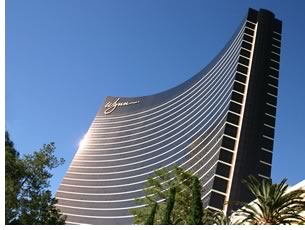 “The real difference is that here in Las Vegas, things have not
yet sorted themselves out,” Steidl explained. “In Las Vegas,
we are in a cauldron where the ideas of place-making and community are
still white hot. What works better in creating lively, people-oriented
communities: top-down or bottom-up control? The experts or the market?
The ‘people’ or charismatic leadership on the order of Burnham
and Olmsted, Robert Moses, Mayor Daley, and Steve Wynn? Which brings
me to this evening’s program.”
“The real difference is that here in Las Vegas, things have not
yet sorted themselves out,” Steidl explained. “In Las Vegas,
we are in a cauldron where the ideas of place-making and community are
still white hot. What works better in creating lively, people-oriented
communities: top-down or bottom-up control? The experts or the market?
The ‘people’ or charismatic leadership on the order of Burnham
and Olmsted, Robert Moses, Mayor Daley, and Steve Wynn? Which brings
me to this evening’s program.”
A simple idea
Steidl began the conversation by asking how Las Vegas’ unique concept
and form of place-making came about. In an evening that was frequently
punctuated with humor, Wynn first responded by joking, “Well, here
you are … the AIA is in Las Vegas of all places. What happened?
Did you get confused? Well, now you’re here and we’ve got
you. But seriously, we and everyone else in Las Vegas are agog and thrilled
that you are here.
“But to your question, any institution that has endurance and vitality, at the root of it will be a simple idea: Who are these people and what do they want? The answers have changed in detail over the years, but not in the fundamentals. Here in Las Vegas, we’re responding to the emotional needs of our visitors.”
Marnell added, “Steve is the kind of person who has a wonderful way of always focusing us on the task by asking, ‘Can we narrow the focus down to what guests need and want?’ As architects, the first priority is to focus on need. Las Vegas is focused on wants. People come to Las Vegas to focus on those extra things that they want. We are not about excess here.”
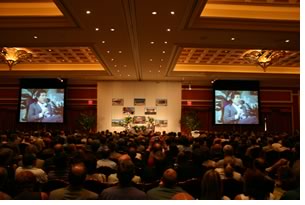 As the audience laughed appreciatively at this, Marnell teased, “You
might be. But we’re not. We’re about determining what you
need and how do we create it without crossing the line.” He explained
that when they design a building like this, he thinks of the idea of
community inside a large building with 9,000 employees. There’s
a dynamic energy between the people who work here and those who come
here to satisfy their wants, he says. “How do we accomplish this?
Is it sustainable or renewable every 48-72 hours, as the next new group
comes in? It’s a complex dynamic that happens.”
As the audience laughed appreciatively at this, Marnell teased, “You
might be. But we’re not. We’re about determining what you
need and how do we create it without crossing the line.” He explained
that when they design a building like this, he thinks of the idea of
community inside a large building with 9,000 employees. There’s
a dynamic energy between the people who work here and those who come
here to satisfy their wants, he says. “How do we accomplish this?
Is it sustainable or renewable every 48-72 hours, as the next new group
comes in? It’s a complex dynamic that happens.”
Human scale vs. size
Wynn picked up the conversation by saying, “If you look here for
subtlety, you won’t find it, although there is a steady trend towards
it. But I have a question that I’d like to pose to you architects.
Is it axiomatic that size and human scale are inverse? Is it a law or
a theory? Well, it turns out that it’s not true. Can you make a
place cozy for lots of people? You can, because you clump up. You go
to certain types of places at certain times of day. During conventions,
we know when you’re going to skip out of the meeting and go worship
the sun, if you still think that’s a good idea. We know when you’re
going to the casinos. We know what type of restaurant you eat at, because
there’s a pattern to how you visit this city, as there is in any
city. We make neighborhoods where you can group according to your preferences
that feel intimate.
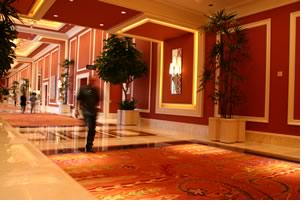 “As architects, you look at the real purpose of the building.
When the hotel opened, two critics from the Los
Angeles Times and the
Wall Street Journal called this curvilinear building ‘banal.’ While
I’m pleased that they took up the issue at all, I think that both
men missed the point completely. This is a hotel and it’s here
to serve the needs of our guests. When you’re evaluating the needs
of your guests, you also consider what they want. They want a great view,
which means a window that spans floor-to-ceiling, wall-to-wall. You’ve
got a glass curtain wall if you give a damn about the guests.”
“As architects, you look at the real purpose of the building.
When the hotel opened, two critics from the Los
Angeles Times and the
Wall Street Journal called this curvilinear building ‘banal.’ While
I’m pleased that they took up the issue at all, I think that both
men missed the point completely. This is a hotel and it’s here
to serve the needs of our guests. When you’re evaluating the needs
of your guests, you also consider what they want. They want a great view,
which means a window that spans floor-to-ceiling, wall-to-wall. You’ve
got a glass curtain wall if you give a damn about the guests.”
Wynn continued, joking, “Now with a curtain wall, you’ve got a lot of options—blue, green, red, or blue. And stripes—it’s either horizontal or vertical. But you give the guests what they want. We would like to build something during our lives to make the L.A. Times critic applaud and cheer, but I have to think of the guests. I want to give them what they want and need—a big window. Are we compromising or taking a step back by building a glass curtain wall? I thought my architectural idea was grounded in common sense, but was excoriated by the critics for having less than brilliant creativity. But you know what? The guests love it! So I am insulated from any real pain by our revenue.”
Common sense and ecology
Marnell and Wynn then took a few questions from the audience. One architect
asked, “As a hotel designer, I can appreciate what you do here,
but as an architect, my problem in coming to Las Vegas is that there’s
no recycling. You offer exquisite beauty, but there’s no sustainability.
In the desert, where resources are so precious, I worry that this is
Rome and it’s destined to fall.”
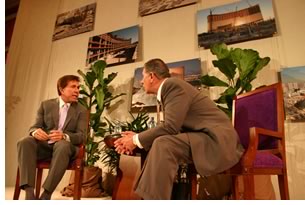 Wynn responded, “I’m going to make you feel better. That’s
a common assumption. Years ago, when I was planning the Mirage, I talked
to a friend of mine at the water company. I told him that I was concerned
about the water it would take to keep up the landscaping. My friend said, ‘You
can be part of the solution or part of the problem. People are out there
watering their lawns, washing their cars, etc., but the water doesn’t
get back to the water table because it gets trapped by the underground
rock. There are pockets of water all over the city that could be used
for landscaping purposes. If you do some test boring around the Mirage
site and clean up the dirty, trapped water, you can use that and won’t
have to use potable water in your landscaping, waterfalls, etc.’
Wynn responded, “I’m going to make you feel better. That’s
a common assumption. Years ago, when I was planning the Mirage, I talked
to a friend of mine at the water company. I told him that I was concerned
about the water it would take to keep up the landscaping. My friend said, ‘You
can be part of the solution or part of the problem. People are out there
watering their lawns, washing their cars, etc., but the water doesn’t
get back to the water table because it gets trapped by the underground
rock. There are pockets of water all over the city that could be used
for landscaping purposes. If you do some test boring around the Mirage
site and clean up the dirty, trapped water, you can use that and won’t
have to use potable water in your landscaping, waterfalls, etc.’
“So that’s what we did. There’s no reason to turn your back on common sense and ecology. We’re not ignoring the issues. We’re dealing with them. We’re at it, and will continue to be.”
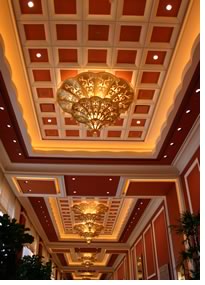 A new standard of beauty?
A new standard of beauty?
A second question asked how the hotel’s Modern exterior coupled
with the opulent interior was justified as a design decision. Wynn answered, “The
curtain wall was a matter of common sense—to give guests what they
want. The interior resulted from my love of color—I’m a passionate
lover of Henri Matisse. The motif of flowers was really an arbitrary
decision, but we felt strongly that we wanted the hotel to have a voice
of its own, independent of time or place. Isn’t it time we try
to interpret the masters in our own way? Maybe we didn’t get it
exactly right, but maybe we did. We’ll see.”
The final question asked “How did you get started together and how do you keep working together?” Wynn responded, “We haven’t settled the change orders yet.” As the audience laughed, he continued, “I’m serious. It’s about $20 million, or something like that. But it was real simple. He’s the best builder.”
Marnell’s response was, “Steve was the guy who was doing things. I was the guy who wanted to build buildings. We met back when we all had on boots and jeans and carried guns. That’s true. But we’re both locked up in this passion. We take it real seriously. Money is one thing; architecture is another. But we’re locked up in this because we share the same passion.”
With that, Steidl thanked both owner and architect by saying, “Your honesty and passion come through, and we appreciate it. Thank you.”
Copyright 2005 The American Institute of Architects.
All rights reserved. Home Page ![]()
![]()
 |
||
Click on a photo to view enlargement. Photos by Aaron Johnson, Innov8iv Design Inc.
|
||